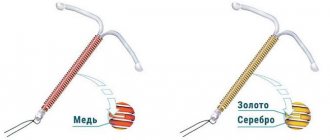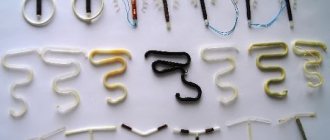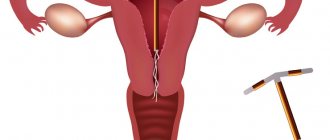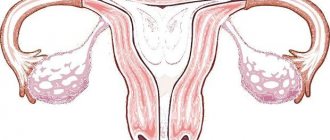Causes of pain in the lower abdomen after installation of the IUD
The intrauterine device prevents the fertilized egg from attaching to the lining of the uterus.
As a result, pregnancy cannot fully develop. Hormone-containing IUDs are also popular. They not only mechanically prevent normal conception, but also affect a woman’s hormonal levels. The likelihood of complications after the introduction of a foreign body into the uterus is reduced. The hormonal drug Mirena is widely used, but side effects may occur from the use of such devices. If your lower abdomen hurts after installing the Mirena coil, it is possible that inflammation of the genital organs is developing.
Immediately after installing a contraceptive device, mild discomfort in the lower abdomen and minor spotting are considered normal. If there is heavy bleeding or severe nagging pain is observed for more than two days, you should contact your gynecologist again.
The duration of abdominal pain after the installation of coils should not be long. After injection, the foreign body “takes root.” This means that the lining of the uterus adapts to the new material.
As a rule, unpleasant symptoms disappear completely within a week. However, the entire adaptation process can take up to three months. Nagging pain often appears in the first days of menstruation.
Features of bleeding during coiling
The following bloody discharge should alert you:
- the duration of which after installation of the intrauterine device exceeds 1 - 2 weeks;
- which are accompanied by severe pain and cramps, an unpleasant odor (indicating the presence of an infection);
- against the background of which there is no menstruation (the doctor should prescribe anti-inflammatory drugs that will help normalize the monthly cycle and prevent the development of dangerous complications).
Sometimes the doctor comes to the conclusion that bloody discharge (light) is absolutely not dangerous and cannot be considered a pathology, even if it continues for several months from the moment the IUD was installed.
However, discharge that lasts long enough after the installation of the intrauterine device is a reason for a thorough examination of the patient. This will help to understand the situation and eliminate the possibility of gynecological pathologies. If the test results turn out to be normal and no changes in the woman’s health are detected, then most likely the doctor will advise you to abandon the intrauterine device and suggest a procedure to remove it. The fact is that prolonged bleeding leads to dehydration of the body and provokes the development of anemia.
Bloody discharge could also begin due to the fact that the doctor incorrectly installed the intrauterine device. As a rule, doctors' errors are detected within 3 months from the moment the contraceptive is installed. Perhaps the IUD was actually installed incorrectly for you, it moved out of place and damaged the mucous membrane of the internal organs, which caused spotting. It is urgent to remove such a device, because apart from the discomfort associated with discharge, there is no need to talk about the benefits of such a contraceptive, because it is absolutely ineffective.
In any case, you need to visit a doctor who will conduct a thorough examination and, if necessary, prescribe diagnostic and therapeutic measures. As mentioned earlier, the coil may have to be removed due to its incorrect position. It may also happen that the specialist will not detect any abnormalities, and the coil will not have to be removed, and the bleeding will go away after some time.
Sincerely, Natalia.
There are more than 50 types of IUDs. The most optimal option for an intrauterine contraceptive device is selected by the doctor after conducting a thorough gynecological examination and the patient undergoing the appropriate examination. The choice of an IUD for each woman is determined individually, taking into account the characteristics and condition of her body.
There are three most common forms of intrauterine devices:
- In the form of a ring;
- T-shaped;
- S-shaped.
The insertion of an IUD (intrauterine device) is a surgical procedure that involves the installation of a contraceptive device into the uterine cavity in order to prevent pregnancy not only in women who have given birth, but also in women who have not given birth. The intrauterine device is one of the most effective means of contraception. The undeniable advantages of this contraceptive include a long period of action (5-10 years) and high efficiency rates (80-95%). The intrauterine device can be removed at any time. Pregnancy after its removal is possible within a year.
Silver, copper or gold are used to make IUDs.
Alarming symptoms
The IUD is a device that is not suitable for everyone. This method of contraception can only be used by women who have given birth. Contraindications include:
- malignant tumors in the uterus;
- underdevelopment of the reproductive system organs;
- the presence of fibroids or polyps in the uterus.
It is strictly forbidden to install a spiral if you have diseases of the pelvic organs or the presence of sexually transmitted infections. Before introducing a foreign body into the uterus, the doctor conducts a visual examination and prescribes a series of tests.
Even if the study has been carried out and no contraindications to the installation of the IUD have been identified, side effects may develop. The female body does not always perceive a foreign body well. As a result, an inflammatory process of the uterine mucosa develops - endometritis. The disease in the acute period will manifest itself with the following symptoms:
- nagging pain in the pubic bone;
- increased body temperature;
- headache;
- dizziness;
- nausea;
- Vaginal discharge with an unpleasant odor (mixed with blood or pus).
If such signs develop, you should immediately seek medical help. Refusal of therapy will lead to inflammation spreading to other organs. There will be a serious threat to the woman's life.
Uterine bleeding (metrorrhagia) is another complication that can develop immediately after installation of the IUD. Seek immediate help if the pad fills completely within an hour. Metrorrhagia often leads to serious blood loss.
Postoperative care
After removing the ingrown IUD, the woman must follow simple rules; complete sexual rest is recommended for 3-4 days. You cannot play sports or lift weights for 1-2 weeks; you must follow the rules of intimate hygiene.
In addition, you should avoid visiting baths, saunas, solariums and swimming pools for 1-2 months. The use of tampons is prohibited, and douching cannot be used as a method of treating diseases of the genital organs. The recovery period can take from 3 to 14 days.
The presence of a foreign body in an internal organ and wearing it for a long time can have a negative impact on a woman’s body. These are not only possible complications, such as the growth of a contraceptive into the wall of the uterus, but also inflammatory and infectious diseases and even rupture of the cervix.
The female body can react to an IUD in different ways, so at the first feeling of discomfort and pain, you should visit a gynecologist and undergo an examination.
More fresh and relevant information about health on our Telegram channel. Subscribe: https://t.me/foodandhealthru
Ways to eliminate pain
If your stomach hurts slightly after installing the Mirena coil or other similar device, you can relieve the unpleasant symptoms with the help of medications. Non-steroidal anti-inflammatory drugs are widely used. The gynecologist will recommend a suitable medicine. The drugs Ibuprofen, Nurofen, Panadol relieve pain well. Medications are recommended for use in extreme cases, when pain prevents you from coping with everyday responsibilities.
Warmth will help relieve nagging pain in the lower abdomen. All you need to do is lie down to rest and place a heating pad on the pubic bone area. You can replace the heating pad with a bag filled with warm salt. Rest in the correct position will also help to alleviate the condition in the first few days after installing the spiral. You need to lie down in a ball and pull your bent legs to your chest. The fetal position helps relax the muscles in the lower abdomen. As a result, pain sensations are not so pronounced.
It is not advisable to massage the abdomen if pain occurs. It must be remembered that there is a foreign body inside the uterus. Intense mechanical stress can damage the endometrium.
If mild discomfort develops into severe malaise, you cannot postpone a visit to the doctor. It is possible that the spiral was installed or selected incorrectly. A specialist can always recommend another effective method of contraception.
Source
How many days can your stomach hurt after insertion of the IUD?
Yesterday I installed the Multiload spiral. After installation, I had pain all day, both nagging and intermittently sharp. I didn’t sleep almost all night, everything hurts. The cervix seems to be rebelling... Even today, on the second day, it hurts and does not subside. Is this normal, do you think? Women, who had the installation, how long after installation did you go to the doctor? Do you really have to remove the spiral? Tell me how it was for you?
Yesterday I installed the Multiload spiral. After installation, I had pain all day, both nagging and intermittently sharp. I didn’t sleep almost all night, everything hurts. The cervix seems to be rebelling... Even today, on the second day, it hurts and does not subside. Is this normal, do you think? Women, who had the installation, how long after installation did you go to the doctor? Do you really have to remove the spiral? Tell me how it was for you?
I put in a ring-shaped Juno spiral with silver, the gynecologist advised me that it takes root better. In general, the survival rate of the spiral is 3 months (according to the gynecologist). I immediately developed complications, pain in the lower abdomen and bleeding. I went to a consultation, but they told me that everything was fine and they didn’t clean it up. In general, all this lasted 2.5 months, then it took root. But not for long. I have a small child, and during menstruation you can’t lift anything heavy, otherwise the coil will fall out. I was carrying the child in my arms and it fell out. In general, I walked with the spiral for 5 months. Now I decided not to suffer and bought the EVRA patch, I am 100% satisfied with it. The most important thing is that you feel comfortable! Good luck!
Mirena hormonal device – review
After reading numerous reviews about the installation of this Mirena system, I decided to write my own review. As they say, as many people as there are so many opinions.
I’ve never had any “female” problems in my life, I’ve never had IUDs or taken pills. After I turned 40, my adventures in the residential complex began.
Initially, after an ultrasound, I was diagnosed with uterine fibroids (not large in size), as well as a polyp. The doctor said I need to go for a hysteroscopy.
After this operation, well, this is the topic of a separate review, the doctors recommended putting on Mirena.
Well, I decided that after this operation nothing else would grow on me and I decided that I shouldn’t act so desperately right away and run to the pharmacy with 10-12 thousand rubles for this miracle spiral! I took the pills recommended after discharge and 3 months later I came for a follow-up ultrasound: And again a surprise - the polyp was again, as if it had never gone away. Again hospitals, tests, surgery….Afterwards the second doctor said. If you don’t put on Mirena, you’ll come again!
Tell me, what will you do in such cases?! After all, we are accustomed to listening to doctors as competent specialists.
Moreover, I have been to more than one doctor! I even went for an ultrasound to a very competent gynecologist professor! In general, there was nowhere to go, and I agreed to install this Mirena spiral.
Let me also clarify that as a contraceptive, I was not interested in this spiral in principle, only for medical reasons. Going to the hospital every six months is also not good, I think.
So here is the installation procedure itself:
On the 4th day after the operation to remove polyps (or, as some call it, cleaning), I was fitted with Mirena. During installation it didn’t hurt, there weren’t any big sensations, I stood up and sat down, my head was a little dizzy, but it went away quickly. There was also a slight nagging pain in the lower abdomen. They said lie down for an hour and you can be free!
When I arrived home, it got ridiculous - you go to the toilet and you’re afraid that it will suddenly fall out, it cost a lot, so much money in the toilet!!! )))))
I am writing a review 12 days after installing the Mirena. After about a week, all the discharge stopped, there was no pain. And now we went again, it felt like my period had arrived. Sit here and think about what this is. I was at an appointment with my doctor at the residential complex, she said, forget about the old cycle, now there’s a new countdown.
So far everything seems to be within normal limits. They talk and write a lot about this, that it bleeds, that the cycle jumps and much more. But let's hope for the best!
After some time I will add my review.
Exactly a month has passed since the installation of the spiral.
I feel fine, I did an ultrasound, they said it’s standing straight, but still be careful, don’t lift heavy things, don’t go to the bathhouse. These days or not these days seem to have come again, nothing is clear yet, but I’m marking everything on the calendar, then I’ll establish a pattern! That's all for now.
Hi all!
I am writing exactly three months later.
Everything is fine, I feel good.
Everything seems to be already forgotten, nothing bothers me, my stomach aches a little before these days.
By the way, the second month the cycle seemed to be established. exactly 28 days, as it was before all this.
I was told that these days would be meager, they say, I could get by with just daily meals. In my case this doesn't work. It runs, of course, much less, but longer, 10-12 days for sure.
In terms of weight, I have no changes, I was and still am 55 kg, my hair seems to be in place too)))))
I need to go for an ultrasound, they said in 3 months. That's all for now. Good health to all of us!
Hi everybody!
I’ll update after three years!
I regularly go for an ultrasound scan twice a year and an appointment with a gynecologist. Everything is fine, no problems.
In general, I am satisfied with everything after installing Mirena. The cycle is also smooth, 28 days. The periods have not gone away, as the doctor asks every appointment - are they coming, yes they are coming, but in a completely different quantity)) Sorry, for the details. but on “these” days I only use daily journals. And events such as a seaside holiday or going to the pool don’t bother me at all.
Some girls write that because they are afraid of getting pregnant, they use various methods (who knows what) because of this there are problems in their intimate life, there is no meaningful sex. I would like to add in this regard, after Mirena, so far there are only advantages, peace of mind and no problems.
I would also like to add that earlier, due to heavy periods, there were problems such as low hemoglobin, because of this pain in the heart, it came to sick leave, injections, pills, ECG...., now there are no more problems with this - and hemoglobin has risen and in general feeling better. I go in for sports (without fanaticism, of course), fitness, swimming pool, skiing.
Maybe there is a hormonal background, after all, Mirena is a hormonal device. In two years (in total, five after installation) I plan to immediately replace it with a new Mirena. All the best and health!)
Source: https://irecommend.ru/content/postavila-po-meditsinskim-pokazaniyam-nadeyus-na-luchshee
What does installing an IUD give?
The variety of IUDs allows you to make an individual choice.
IUDs are made from different materials and have different shapes, but the essence of their use is the same: to prevent unwanted pregnancy.
Operating principle
is based on preventing the implantation of a fertilized egg; in addition, there are a number of intrauterine devices that contain a hormonal drug that can change a woman’s hormonal background.
Under the influence of the hormone, the thickness and functional ability of the endometrium decreases, the viscosity of cervical mucus increases, which is a protective barrier against sperm.
In some cases, after removing the IUD from the uterus, fertile function is restored quite quickly, so this method of contraception does not lose its popularity and remains the safest for preserving a woman’s reproductive health.
The intrauterine device is installed for a period of 3 to 5 years, then it is necessary to take a break to prevent irreversible consequences. The service life of an IUD depends on the consumables from which it is made, the supplier, and many other factors. Menstruation immediately after removal of an IUD with a hormonal component should return within 12 months.
Of course, the woman is concerned about the question: “How effective are intrauterine devices?”
The effectiveness of the mechanism of action of the IUD is close to 100%, and it should be noted that this is a fairly high figure, because using condoms as a method of contraception gives 88% effectiveness, and when taking oral contraceptives 97%.
For nulliparous women
, due to the likelihood of developing secondary infertility, it is better to choose a different method of contraception.
Is it painful to have an IUD inserted?
How painful it is to insert an intrauterine device depends on the patient’s pain threshold. For some women, inserting a contraceptive does not hurt at all, while others require an anesthetic. Judging by women's reviews, inserting an IUD is practically not painful. The doctor’s manipulations during the procedure may cause discomfort and unpleasant sensations, but severe pain when inserting the intrauterine device is excluded.
For nulliparous patients, as well as for women who have recently started sexual intercourse, inserting an intrauterine device may be a little painful. This is due to high muscle tone and a narrow cervical canal.
If a woman before the procedure is worried about whether it hurts to insert an IUD, then she can take no-shpa to relieve spasms and relax muscles. For particularly sensitive patients, motherwort tincture or another sedative will help. If inserting an intrauterine device is very painful for you, be sure to tell your doctor. He will treat the cervix with an anesthetic, which will relieve pain.
According to doctors, it is better to use a contraceptive on days 4-8 of the cycle. During this period, the cervix is slightly open, so inserting the intrauterine device does not hurt at all. Also, the presence of menstruation allows you to exclude a possible pregnancy, in which inserting an IUD is prohibited.
However, if necessary, inserting an intrauterine device is allowed on any other day. For example, during the postpartum period, an intrauterine contraceptive is allowed to be inserted one and a half months after the birth of the child. At this time, for most women (especially during lactation), the monthly cycle does not have time to recover.
Is it painful to have an IUD inserted without a period? Inserting the IUD during this period is a little painful due to the narrowed uterine os. Also, before the procedure, you need to make sure that there is no pregnancy.
Types of intrauterine devices
To decide which intrauterine device is better, a representative of the fair sex should learn about all the characteristics and parameters of this contraceptive, evaluate the disadvantages and advantages.
The most commonly installed spirals are Nova T, Juno Bio, Multiload and Mirena.
Nova T
. The name itself emphasizes its shape, which resembles the letter T. This is due to the anatomical features of the structure of the uterus. The IUD is made of modern plastic and braided with copper.
Copper has a detrimental effect on sperm.
The disadvantages of a contraceptive include:
• the possibility of individual hypersensitivity reactions,
• risk of developing inflammatory pathology of the genitourinary system,
• the likelihood of bleeding, sanguineous discharge after insertion of the IUD.
Spirals Juno Bio
come in different forms. Juno Bio T is made of modern medical plastic and a special thread that controls the placement of the spiral in the uterine cavity and allows you to remove it without much difficulty.
Juno Bio Super
additionally treated with propolis and an antibacterial composition, which helps prevent the development of infectious pathology.
Spiral Juno Bio with silver
, due to the known bactericidal properties of silver, can remain in the uterine cavity for a long time, for up to 7 years. An IUD in the shape of a ring with a rod containing silver and copper, the service life of the intrauterine contraceptive is from 3.5 to 7 years. The rod allows you to remove the IUD from the uterus if necessary.
Multiload and Multiload Navy
– oval-shaped spirals with soft protrusions that help fixate in the uterine cavity, which virtually eliminates the risk of prolapse. Service life 5 years.
Mirena
The spiral is T-shaped and can be easily removed due to the ring specially provided for this purpose. Additionally, it has a container with a hormonal substance - levonorgestrel, which is released into the uterine cavity in equal portions. The high contraceptive effect of the IUD is explained by the combination of the hormonal drug and the mechanical action of the IUD itself. The disadvantages of Mirena include its high cost and the development of amenorrhea (absence of menstruation) in approximately 22% of cases.
So it is not possible to answer the question, which spiral is better; in each case, this is decided individually, assessing all the characteristics of the woman, after consultation with a doctor.
How does the IUD work?
The purpose of the IUD is to protect against unplanned pregnancy. The name suggests that it is inserted into the uterine cavity, and it was obtained due to the previous appearance of the product, as it looked like a spiral. Currently, the IUD is a T-shaped stick made of flexible inert plastic. This material is completely safe for women's health.
There are two types of spirals:
- The upper part of the spiral is in the form of a thin copper wire.
- The spiral contains a container with hormones that enter the uterus throughout its entire lifespan.
It has both the first and second types of pros and cons. The photo above shows what this type of contraception currently looks like.
The principle of operation of the spiral:
Who can install a spiral:
- A woman who has given birth and is over 35 years old.
- Women who have children after an abortion without complications.
- Without cervical pathologies.
- If you protect yourself with oral contraceptives, it is not recommended.
- Women who have a low rate of sexually transmitted infections.
Side effects and possible complications from the IUD
Every female representative should be aware of the possible adverse effects and side effects of the IUD.
Side effects of the IUD after installation
• Irregularity of the menstrual cycle.
• Increased vaginal discharge, possibly with an unpleasant odor.
• The appearance of intermenstrual bleeding. After insertion of the IUD, there may be a discharge similar to menstruation.
• Painful sensations in the lower abdomen.
• Increased risk of developing ectopic pregnancy.
• The risk of developing infertility, since after choosing the IUD as a contraceptive method, in some cases, it is difficult to get pregnant.
Pregnancy after removal of the IUD usually occurs within a year, but some women become pregnant in 1-2 menstrual cycles immediately after removal of the IUD; in 30% of women, pregnancy occurs after 3 months.
Doctors usually recommend waiting 3-4 months for the endometrium to recover, otherwise the outcome of an “early” pregnancy after removal of the IUD may be a miscarriage
Sex after insertion or removal of the IUD is possible after 10 days, if there are no inflammatory consequences.
With low qualifications of the gynecologist and an incorrectly selected IUD, the development of infectious complications of the pelvic organs, perforation (through wound of the uterine wall), and spontaneous prolapse of the IUD may occur.
Expulsion
Expulsion (rejection) of the IUD is also a relatively common complication (5-16% of cases when using copper-containing IUDs and 5-6% of cases when using the Mirena hormonal intrauterine system).
Young nulliparous women are most susceptible to this complication. With age, as well as with an increase in the number of pregnancies (including those that ended in abortion), the likelihood of expulsion decreases.
Most often, this complication develops in the first days or first three months after installation of the IUD. Often, especially in the first days and weeks after installation, expulsion is accompanied by intense cramping pain in the lower abdomen, which is practically not relieved by analgesics and antispasmodics.
In such cases, differential diagnosis with other complications is necessary, such as inflammatory diseases of the pelvic organs, ectopic pregnancy, and interrupted physiological pregnancy.
If intense pain that cannot be relieved by analgesics and antispasmodics occurs in the first days after installation of the IUD, it may indicate an incorrect position of the IUD, a mismatch between the IUD and the size of the uterine cavity, or such a serious complication as uterine perforation.
To clarify the causes of pain, ultrasound or hysteroscopy is usually prescribed. In case of IUD expulsion, the woman is advised to choose another method of contraception.
However, the IUD can fall out relatively painlessly, so women using an IUD should regularly (after every period) check for the presence of the IUD tendrils at the cervix.
In cases where the antennae of the spiral cannot be felt, it is necessary to urgently consult a doctor. As a rule, an ultrasound is prescribed to determine the location of the spiral. If the study shows that there is no IUD in the uterus, you should either insert a new IUD or choose another method of contraception.
What to pay attention to before installation
Despite the fact that the IUD is a reliable way to protect against unwanted pregnancy, the IUD does not affect the possibility of contracting a sexually transmitted infection.
This means that during casual sex it is necessary to use condoms to avoid sexually transmitted diseases, since the IUD itself does not make sex safe.
Any independent manipulation of the spiral is unacceptable.
After childbirth, it is better to install an IUD after the resumption of the normal menstrual cycle, 2-5 days after the appearance of bleeding.
The procedure for inserting an intrauterine device is practically painless; after insertion of the IUD, minor nagging pain in the lower abdomen and light bleeding from the vagina are allowed.
After insertion of an intrauterine device, anti-inflammatory treatment is necessary to prevent the development of infectious pathology. A short course is justified by taking a broad-spectrum antibacterial drug, for example, from the group of levofloxacins.
Minor nagging pain in the lower abdomen after insertion of an IUD (as during menstruation) can be relieved with a non-steroidal anti-inflammatory drug - Diclovit suppositories. The course of administration is 5 days transrectally.
Installation of an IUD is an intervention in a woman’s nature, which means that vaginal dysbiosis may occur, so an antifungal drug is added to preventive therapy, for example, 150 mg of Flucostat once.
What are the disadvantages of the IUD?
There are also negative aspects of using an IUD:
- There is a high risk of ectopic pregnancy.
- There is no protection against sexually transmitted diseases.
- The risk of inflammatory diseases increases.
- Cannot be used by nulliparous women.
- Painful periods for the first six months.
- Large blood losses are possible.
We looked at the pros and cons of a contraceptive such as an intrauterine device. We will consider the consequences of BMC further.
What is the reason to contact a gynecologist?
A woman needs to be attentive to her health and at the first unfavorable signs, consult a doctor.
What should you be wary of?
:
• Increased temperature reaction, pain in the lower abdomen.
• Spotting after IUD insertion.
• Vaginal discharge of a different nature than usual.
• Delay in the onset of menstruation by more than 2-3 weeks.
In addition, it is necessary to control the length of the threads in the vagina; they should always be at approximately the same level; if you notice otherwise, this may mean that the contraceptive has migrated deep into the uterine cavity, which is a good reason for examination by a gynecologist.
If, after installing the IUD, your stomach hurts or there is heavy bleeding, nausea, or widespread pain in the pelvic area, then you should consult a doctor.









